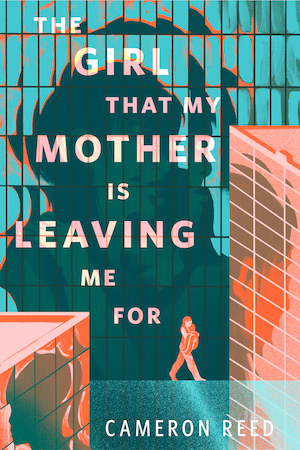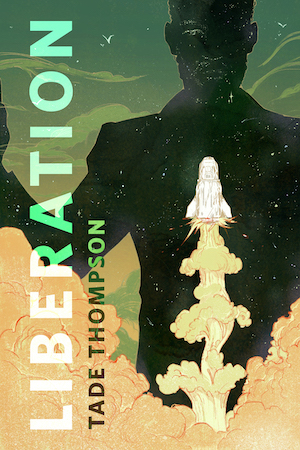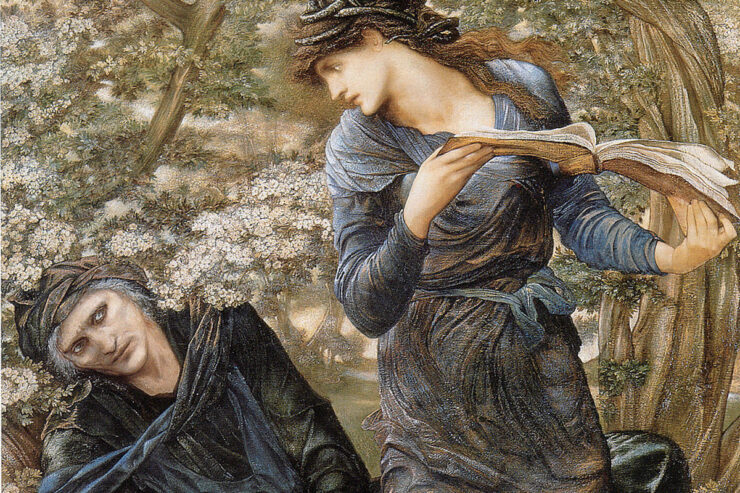“In this misty land the borderline between myth, legend and fact is not decisive, my father says, as a stone arch might be between this world and another, but more like a series of moving veils or woven webs between one room and another.”
—Possession, p. 400
When A.S. Byatt passed away in November last year, the world lost a great fantasist as well as a Booker Prize-winning author. Whilst Byatt’s literary fiction might appear to be as far from traditional fantasy as possible, scratch the surface of almost any of her novels or disconcertingly strange short stories and you find an imagination suffused with myths and legends, alive to the possibility of the fantastic. Byatt was obsessed with myths, particularly Norse mythology, and the fantastical otherworld of fairy that haunted the Romantics, because these are very old stories that humans have told and retold to each other for thousands of years, and Byatt was interested in the peculiar and transcendent magic of storytelling.
The fantastical elements in a Byatt story may not necessarily cross over into the diegetic world of the main narrative—although they frequently do, especially in her short stories—but they are always there, underpinning the fabric of the story and subtly guiding and shaping the interior lives and the fates of the characters. I’m going to talk about how Byatt’s unique approach to the fantastic, looking at her most famous work, the Booker Prize-winning novel Possession: A Romance (1990), her reimagining of the Norse myths in Ragnarok: The End of the Gods (2011) and her short fiction.
Possession is a novel concerned with the multiple meanings of its title, supernatural and otherwise. On the most basic level of story, it’s a literary thriller about Roland Mitchell, a struggling academic who discovers some handwritten letters by (fictional) Romantic poet Randolph Henry Ash which imply a tempestuous relationship between Ash and fellow (also fictional) Romantic poet Christabel LaMotte, something that could completely recontextualize the world of academic study surrounding these two poets. Mitchell and Maud Bailey, Mitchell’s counterpart in LaMotte studies, must work together to follow a series of clues to uncover the truth about the two poets’ romantic tryst before their rivals can swoop in. As such, it’s concerned with the strange possessiveness academics feel over their research subjects, as well as the often-thorny issue of who owns the rights to an artist’s personal correspondence generations after their death.
But Possession is a complex puzzle-box of a book, and it’s unwise to assume anything flows only in the one direction. Just as the academics fight over possession of Ash and LaMotte’s effects and their own sense of ownership of the poets’ work, so they find their own lives overwritten and overwhelmed by the passion and vision of these two long-dead poets. Byatt masterfully creates a polyphony of voices in her novel, interspersing modern sections describing Roland and Maud’s exploits with diary entries and letters from Randolph, Christabel, and their friends and relatives, as well as both poets’ poetry. None of this would work if Byatt were not a master of voice, effortlessly able to capture the interior voices of her characters as well as convincingly portraying the elemental magic and fire of the Romantic’s poetry. Incredibly, Byatt is able to do just that, creating poems that engage with nature and mythology in the same way as the Romantics whilst demonstrating how the poets’ real-life experiences of love and loss are transmuted into art via their incredible talent and imaginations. Possession expertly mixes all of these contrasting records of lives and experiences, read and reread across centuries, building up to an impressive sculpture of narrative which only the novel’s reader is able to piece together and appreciate as a magnificent whole.
So what does this have to do with fantasy and the fantastic? For those like Randolph and Christabel, who live in a world of their own imagination, or those like Roland and Maude, who spend their life exploring someone else’s imagination, the answer is: everything. Both Randolph and Christabel’s work is rich in allusion, and both become fixated on the legends of Ys, the mythical sunken city of Brittany, and Melusina, the woman/water spirit who is part fish. Both of these images, that of a city’s doomed inhabitants at the mercy of forces far greater than themselves, and of a woman who has a terrible secret that she must keep from her lover, become central to both poets’ imaginations and writings. Randolph and Christabel’s relationship is fraught by practical difficulties and guilt, as Randolph is already married, and Christabel lives with her friend and possible lover Blanche Glover, and fiercely protects her private life, painfully aware of the restrictions placed on her behavior as a woman in 1800s England.
The images of Ys and Melusina recur in both Randolph and Christabel’s poems, where they symbolize different things. Byatt expertly shows us how myths and legends resonate through the artist’s private life and provide them with a language and a medium through which to transmute their experiences into art. As well as providing the context and the expression of the poets’ tempestuous affair, there is a sense in which their lives are being shaped by the stories and legends. This is reflected again in the way in which the poets’ lives and the poets’ art influences and shapes Roland and Maude’s romantic relationship so many years later, infusing the lives of these repressed and introverted scholars with the passion and intensity of Randolph and Christabel’s romance. Of course, being keenly observant and aware of the way narratives work, Roland and Maude can’t help but be a little bit aware of this process happening to them:
Somewhere in the locked-away letters, Ash had referred to the plot or fate which seemed to hold or drive the dead lovers. Roland thought, partly with precise postmodernist pleasure, and partly with a real element of superstitious dread, that he and Maud were being driven by a plot or fate that seemed, at least possibly, to be not their plot or fate but that of those others. (504)
Throughout Possession, narrative and imagination have an inexorable influence over the novel’s characters, influencing each other across media and centuries, to the extent that stories themselves seem to have more agency than any of the characters.
The fantastic has a similarly oblique but profound role in Ragnarok. The book is simultaneously a retelling of the Nordic myths and a reflection on why these stories retain such power over the human imagination. The myths are told in parallel with the story of a young girl during World War II, who discovers the myths through a copy of Asgard and the Gods at a time when the world around her is making less and less sense. The child seems to be largely based on Byatt herself, and in her own experiences growing up during the war and reading the Norse myths. This creates a feeling of deeply personal connection between the book, the reader, and its meta-subject matter. Byatt tells of the gods with lyrical prose, drawing them unavoidably toward the inevitable destruction of all things waiting at the end of the world. But we also get to see how these stories have a direct effect on her young mind, how they help her make sense of the world, how they inspire in her a desire to write and imagine her own stories:
The picture gave the child an intense, uncanny pleasure. She knew, but could not have said, that it was the precise degree of formlessness in the nevertheless scrupulously depicted rocks that was so satisfactory. The reading eye must do the work to make them live, and so it did, again and again, never the same life twice, as the artist had intended. She had noticed that a bush, or a log, seen from a distance on her meadow-walk, could briefly be a crouching, snarling dog, or a trailing branch could be a snake, complete with shining eyes and flickering forked tongue.
This way of looking was where the gods and giants came from.
The stone giants made her want to write.
They filled the world with an alarming energy and power. (10)
For Byatt, the myths connect us to the primal self who sees goblins and monsters in the dark. The harsh, unforgiving nature of the Norse gods is directly contrasted with the Christian God the child learns about at church—there is something about the unknowable, inhuman arrogance and violence of the Norse gods that make them feel more real to her than the forgiving, benevolent New Testament deity, something that connects directly to the world of Grimms’ fairy tales. These are stories that warn of unseen menaces in the night, and so open up spaces where the imagination can roam free.
The Norse myths give the child a context within which to frame the unfathomable and seemingly unending horrors of the war, as London is bombed and she is evacuated to the countryside. The elemental violence of the Norse myths finds a resonance in the horror and destruction. This way of seeing and understanding the world stays with the child, as we follow her into adulthood where the world is under threat of environmental collapse. Environmental catastrophe becomes reflected in the death of the world tree Yggdrasil, a terrible fate brought about by our own hubris as we poison the very planet that gives us life. Thus, mythology for Byatt not only opens a door for one to connect with one’s own primal imagination, it provides us with an ever-evolving and relevant language for encountering and processing the immensity of existence, those things that are so much larger than human life and understanding, however it manifests in our current age. Once again, it is stories, and in particular myths and legends, that have the true agency here.
The importance of stories and the fantastic can also be seen throughout Byatt’s wonderful short stories, many of which are collected in Medusa’s Ankles (2021). Byatt tends to allow the fantastical and the supernatural to encroach more directly on her short fiction than in her novels, but they share with her longer work her intricate construction and her fascination with the ways in which storytelling shape our lives. “The Djinn in the Nightingale’s Eye,” which won the 1998 Mythopoeic Fantasy Award for Adult Literature, is a remarkable piece of fiction that uses nested stories and the register of the tales of the Arabian Nights to tell a quintessential story about stories—a professor of narratology visits a conference in Ankara, trades stories with colleagues and tour guides, and eventually finds herself falling in love with a djinn. Once again there is a sense in which the stories the characters tell wind up shaping their own lives. As one of the professor’s friends remarks in one of the many nested stories that unfold:
It is as though our dreams were watching us and directing our lives with external vigour whilst we simply enact their pleasures passively, in a swoon. (184)
The short story form allows Byatt to effortlessly show off her range whilst playing with form. The Romantics are never far from Byatt’s stories—“A Lamia in the Cévennes” imagines an encounter between an artist and Keats’ Lamia in a swimming pool in the French countryside, whilst “Precipice-Encurled” sets a series of framed narratives around the poet Robert Browning, the real-life model for Possession’s Randolph Henry Ash. “Dragon’s Breath” and “Cold” read like meta-takes on fairy tales, using the reader’s familiarity with the form to subvert expectations. “Doll’s Eyes” is a straight-up horror story, whilst “The July Ghost” is a melancholy take on the ghost story, with loss itself doing the haunting. There are even touches of the Weird in places, as in the masterful “A Stone Woman,” which sees its central character undergoing a lithic transformation into a troll. Throughout them all is the sense that stories happen when the unexpected, whether it be the supernatural or an unfamiliar character seizing the reigns of the narrative, irrupts into the mundane, and that stories come about to help us understand these disturbances.
Byatt’s unusual and complex approach to genre means that very little of her work sits easily under the banner of fantasy, but she spent her life exploring the magical hold that stories have over all of our lives. Her novel The Children’s Book (2009) draws on the lives of E. Nesbit and J. M. Barrie to tell a story about a family shaped by Olive Wellwood’s decision to write children’s books, whilst even her realist Quartet, beginning with The Virgin in The Garden (1978), is obsessed with how words and terminology shape our reality. Adventurous readers will find in her work a wealth of imagination and a deep appreciation of mythology and the fantastic. Her intricately constructed novels and stories poke holes in their own fictionality, creating a delightfully uncanny sense of unease. But it is Byatt’s love for the fantastic and her unwavering exploration of how fantastical stories shape our lives that make her work resonate so meaningfully with fantasy, and hint at exciting new ways for the bold to approach the fantastic.











Thanks, something new to me. More added on to the audio-book queue and TBR pile. Looking forward to it!